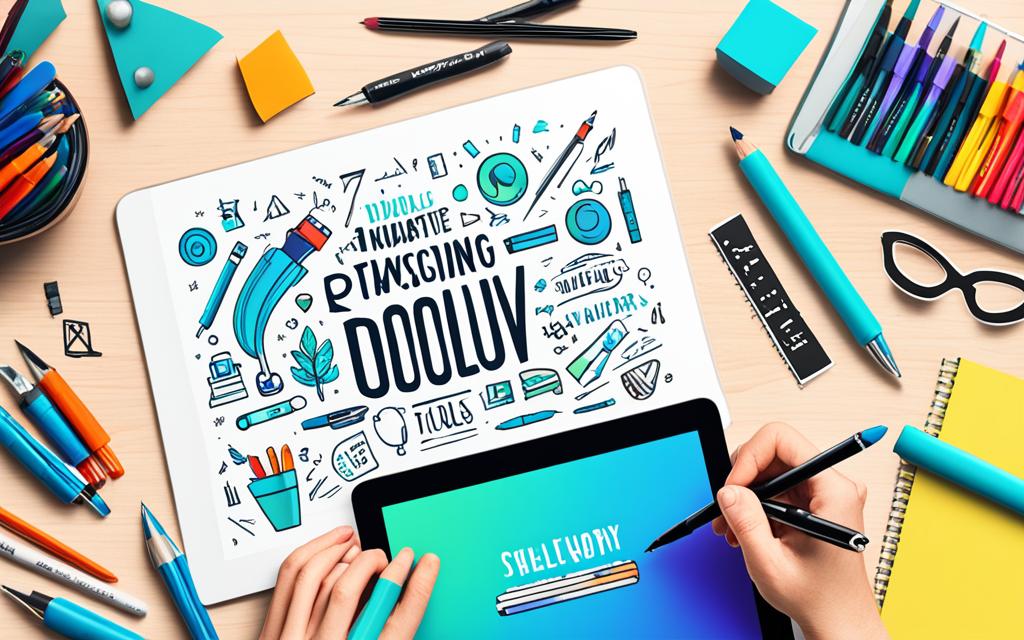Table of Contents
Typography is a crucial aspect of design that can greatly influence the impact and effectiveness of advertising materials. By carefully choosing fonts, establishing visual hierarchy, and ensuring legibility, designers can create designs that capture attention and establish a strong brand identity. In this article, we will explore the importance of typography in advertising and how it can be leveraged to create impactful designs.
Typography plays a significant role in enhancing communication and establishing brand recognition. Consistency in typography across all materials helps build a cohesive and recognizable brand identity, setting the brand apart from its competitors. By adapting typography to cultural and regional preferences, advertisers can also target diverse markets effectively.
In the following sections, we will delve into specific aspects of typography in advertising, such as enhancing visual hierarchy, setting the tone and mood, establishing brand recognition, ensuring legibility, and differentiating from competitors. Understanding these principles and utilizing typography tools design can greatly enhance the impact and effectiveness of advertising designs.
The Importance of Typography in Advertising
Typography plays a critical role in advertising, extending beyond mere font selection. It serves as a powerful tool that significantly influences how advertising messages are perceived and remembered. By leveraging the right typefaces, advertisers can enhance communication, strengthen brand identity, and forge deeper connections with their target audience.
One of the key benefits of typography in advertising is the establishment of a clear visual hierarchy. By varying font sizes, styles, and weights, advertisers can emphasize important information such as headlines, taglines, or calls-to-action. This structured approach guides the viewer’s attention and ensures that the most critical message stands out amidst the visual clutter.
The tone and mood of an advertisement can also be effectively conveyed through typography. Different typefaces evoke distinct emotions and communicate specific tones. For example, serif fonts can convey a sense of tradition and elegance, while sans-serif fonts are often associated with modernity and simplicity. Advertisers can align the typography choices with their brand’s desired emotions and personality, creating a deeper connection with the target audience.
Furthermore, typography plays a vital role in ensuring legibility. No matter how creatively designed an advertisement may be, its message will only be effective if the typography is easy to read. Factors such as font size, spacing, and color contrast need to be carefully considered, particularly in digital ads where viewers have limited time to grasp the message.
In addition to enhancing communication, typography can differentiate a brand from its competitors. By using custom or unique typefaces, advertisers can create a distinctive look that resonates with their target audience. A well-crafted typography style becomes a signature element that makes the brand more memorable and recognizable in a crowded market.
Typhography is a powerful tool in the hands of advertisers to create impactful designs that effectively communicate messages, strengthen brand identity, and connect with the target audience.
Overall, typography holds immense importance in advertising as it shapes the way messages are perceived, helps establish a brand’s identity, and enhances the connection with the target audience. Advertisers should prioritize typography choices to create impactful designs that leave a lasting impression.
Enhancing Visual Hierarchy with Typography
Typography is a powerful tool that allows advertisers to establish a clear visual hierarchy in their communication. By strategically varying font sizes, styles, and weights, important information such as headlines, taglines, or calls-to-action can be emphasized, guiding the viewer’s attention through the content in a structured manner.
A well-structured visual hierarchy ensures that the most critical message is preserved amidst the visual clutter, increasing the effectiveness of the ad. By utilizing typography to create a hierarchy of information, advertisers can prioritize key messages, making them easily noticeable and memorable to the audience.
For example, consider a print ad featuring a product promotion. By using a larger, bold typeface for the headline and a smaller, regular typeface for the supporting text, the visual hierarchy is established. The headline immediately catches the viewer’s attention, while the supporting text provides relevant details. This hierarchical layout directs the viewer’s focus towards the most important aspect of the ad, resulting in a more impactful and efficient communication.
Furthermore, typography can be used to create a visual contrast that highlights specific elements within the design. For instance, using a different typeface or style for a call-to-action button can make it stand out from the rest of the content. This contrast draws attention to the button and encourages user interaction, improving the overall user experience.
To illustrate the concept of enhancing visual hierarchy with typography, take a look at the following example:
One of the most famous examples of visual hierarchy through typography is the branding of Coca-Cola. The brand’s logo features a distinctive typeface and red color, which immediately grabs attention and creates a strong visual hierarchy. The word “Coca-Cola” is prominently displayed, establishing hierarchy within the logo itself. This consistent use of typography has contributed to Coca-Cola’s brand recognition and differentiation for over a century.
| Typography Elements | Impact on Visual Hierarchy |
|---|---|
| Font Size | The use of larger fonts for headlines and smaller fonts for supporting text helps establish a clear hierarchical structure, directing the viewer’s attention. |
| Font Style | Using bold, italic, or underlined fonts selectively guides the viewer’s eye towards important information or specific design elements. |
| Font Weight | Applying variations in font weight, such as bold or light, creates contrast and emphasis, leading to a more pronounced visual hierarchy. |
In conclusion, typography plays a crucial role in enhancing visual hierarchy in advertising. By strategically manipulating font sizes, styles, and weights, advertisers can guide the viewer’s attention, prioritize key messages, and improve the overall impact of their designs.
Using Typography to Set the Tone and Mood
Different typefaces evoke unique emotions and convey specific tones. Serif fonts exude a sense of tradition and elegance, while sans-serif fonts are often associated with modernity and simplicity. Advertisers can align their brand messaging with desired emotions and personality by choosing suitable typefaces, forging a deeper connection with the target audience. Typography sets the tone and mood of the communication, enhancing the brand experience.
When selecting typefaces, advertisers should consider the personality and values of their brand. For instance, a luxury brand may opt for a serif font to convey sophistication and refinement, while a tech company might choose a clean, minimalist sans-serif font to communicate a modern and innovative image. By carefully choosing the right typefaces, advertisers can craft a visual language that resonates with their audience and evokes the desired emotional response.
Typography also plays a crucial role in creating a cohesive brand experience. Consistency in typeface usage across all marketing materials, including advertisements, packaging, websites, and social media, helps maintain brand recognition and reinforces the desired tone and mood. By consistently using the same typefaces, advertisers can build a strong visual identity and differentiate themselves from competitors.
Here are some examples of typefaces and the emotions they can evoke:
| Typeface | Emotions |
|---|---|
| Times New Roman | Tradition, reliability, elegance |
| Arial | Modern, clean, straightforward |
| Verdana | Informal, friendly, approachable |
| Helvetica | Modern, minimalist, professional |
By understanding the emotional impact of different typefaces, advertisers can strategically select fonts that align with their brand’s personality and effectively communicate the intended message. Typography, combined with other design elements, can evoke a specific atmosphere, whether it’s the nostalgia of a vintage brand or the excitement of a cutting-edge technology product.
Establishing Brand Recognition and Consistency
Consistency in typography is paramount for building brand recognition and establishing a strong brand identity. By using a set of brand-specific fonts consistently across all advertising materials, from advertisements and websites to packaging and social media, businesses can create a cohesive and recognizable brand identity that captures the essence of their brand.
When customers encounter consistent typography, the visual cues immediately associate it with the brand, reinforcing brand recall and loyalty. Typography becomes a signature element that sets the brand apart from its competitors, making it instantly recognizable and memorable.
Establishing consistent typography involves careful consideration of font choice, font size, and font style. By using a well-defined and cohesive set of fonts, businesses can ensure that their brand message is communicated effectively and consistently across all platforms and touchpoints.
Moreover, consistent typography fosters a sense of professionalism and reliability. When customers see the same typography used consistently in all brand communications, they develop a sense of trust and familiarity with the brand, which is essential for building long-term relationships.
Example of Consistent Typography for Brand Identity
| Brand | Typography | Examples |
|---|---|---|
| Apple | San Francisco Pro | |
| Coca-Cola | Spencerian Script | |
| Nike | Nike Futura |
By consistently using the same typography across different brand materials, businesses can reinforce their brand identity, increase brand recognition, and stand out from the competition. Consistent typography ensures that every touchpoint with the brand leaves a lasting impression, strengthening the overall brand image and increasing customer loyalty.
Ensuring Legibility and Readability
No matter how creative or eye-catching the design, the message will only be effective if the typography is easy to read. Legibility is of paramount importance in advertising. Advertisers must consider factors like font size, spacing, and color contrast to ensure easy reading, especially in digital ads where viewers only have a few seconds to grasp the message. Typography choices should prioritize legibility to ensure the successful delivery of the intended message.
Incorporating legible typography is a crucial aspect of designing effective advertisements. Advertisers should carefully select fonts that are readable and visually pleasing to the target audience. Ensuring an appropriate font size is essential as it enables viewers to comfortably consume the content without straining their eyes or losing interest. While smaller font sizes may be suitable for certain design elements or fine print, larger fonts are generally more legible and encourage easy reading.
In addition to choosing the right font size, maintaining sufficient spacing between letters and lines aids in legibility. Ample letter spacing, also known as tracking, allows each character to be distinct and prevents them from blending together. Similarly, adequate line spacing, known as leading, ensures that lines of text are comfortably spaced apart, enhancing readability. By incorporating appropriate spacing, advertisers can make the copy visually digestible and minimize the risk of confusion.
Color contrast is another essential consideration for legibility. Advertisers should aim for a clear contrast between the text color and the background to facilitate easy reading. In digital advertising, where different devices and screen settings may affect the way colors appear, it is crucial to test the readability across various platforms. By selecting colors that create a noticeable contrast, advertisers can ensure that the message is easily understood and grabs attention.
“Legibility is the key to effective communication through typography. Without legibility, the message gets lost, and the design becomes ineffective.”
Applying proper typography techniques for legibility and readability not only helps deliver the intended message effectively but also enhances the overall user experience. By making the typography legible and easy to read, advertisements can capture viewers’ attention, maintain their interest, and ensure the successful transmission of the desired information or call to action. Prioritizing legibility in design is an investment in the effectiveness of advertising campaigns and the clarity of communication.
Differentiating from Competitors with Typography
Typography can be a powerful tool to set a brand apart from its competitors. By utilizing unique typefaces and font choices, advertisers can create a distinctive look that resonates with their target audience and helps establish a strong brand identity. A well-crafted typography style becomes a signature element that makes the brand more memorable and recognizable in a crowded market.
Custom typefaces play a crucial role in brand differentiation. By designing or commissioning their own font, brands can have a truly unique and proprietary typographic identity. This not only sets them apart from competitors but also adds a touch of exclusivity and sophistication to their overall brand image. Custom typefaces allow advertisers to communicate their brand personality and values through every piece of content they create, enhancing the overall brand experience.
It is essential for typography choices to align with the brand’s positioning and values. A consistent typographic approach across various advertising materials reinforces the brand message and builds brand recognition. Advertisers should carefully consider the typography that aligns with their unique brand proposition and target audience. By selecting fonts and typefaces that reflect the brand’s character, advertisers can effectively differentiate their brand and attract the attention of their desired audience.
Examples of brands differentiating themselves through typography
“Netflix, with its custom typeface called ‘Netflix Sans’, has successfully created a distinct typographic identity that aligns with its modern and forward-thinking brand image. The unique typography not only sets them apart from their competitors but also reinforces their innovative and disruptive positioning in the entertainment industry.” – David Johnson, Creative Director at Typo Design Agency
“Samsung’s use of their custom typeface ‘SamsungOne’ across their various touchpoints has allowed them to establish a consistent and recognizable brand identity. The custom font reflects their commitment to innovation and attention to detail, setting them apart from other tech brands and conveying a sense of trust and reliability to their customers.” – Sarah Thompson, Brand Consultant
Brands Differentiating Through Typography
| Brand | Typography Approach | Differentiation Factor |
|---|---|---|
| Netflix | Custom typeface – Netflix Sans | Modern and innovative brand image |
| Samsung | Custom typeface – SamsungOne | Consistency and trust in the tech industry |
| Apple | San Francisco font | Clean and minimalist design |
| Coca-Cola | Spencerian Script | Classic and timeless brand image |
By adopting custom typefaces and selecting typography that embodies their brand essence, advertisers can effectively differentiate their brand from competitors. Typography becomes a powerful tool for creating a lasting impression, reinforcing brand values, and attracting the target audience.
Conclusion
Typography is an integral aspect of effective design and advertising. By leveraging typography tools design, advertisers can enhance communication, establish brand identity, and connect with their target audience on a deeper level. Typography plays a vital role in creating a visual hierarchy, setting the tone and mood of communication, ensuring legibility, and differentiating the brand from its competitors.
Choosing the right typefaces, creating a consistent visual hierarchy, and adapting typography to cultural preferences are essential strategies for impactful design. Moreover, typography allows advertisers to establish a clear structure for their content, guiding the viewer’s attention through the material in a structured manner.
To create a strong brand identity, advertisers should prioritize typography choices and utilize the right tools. Consistency in typography across all advertising materials helps build brand recognition and reinforces brand recall and loyalty. Additionally, advertisers can use custom or unique typefaces to differentiate themselves in a crowded market, making their brand more memorable and recognizable.
FAQ
What role does typography play in advertising and design?
Typography plays a significant role in advertising and design by enhancing communication and establishing a strong brand identity.
How does typography help with impactful design?
Choosing the right fonts, creating visual hierarchy, and ensuring legibility are essential for impactful design.
Why is consistency in typography important?
Consistency in typography across all materials helps build brand recognition and differentiation from competitors.
How does typography contribute to brand recognition?
Typography becomes a signature element that sets the brand apart from its competitors, reinforcing brand recall and loyalty.
What should advertisers consider for legibility in typography?
Advertisers must consider factors like font size, spacing, and color contrast to ensure easy reading and successful message delivery.
How does typography differentiate a brand from competitors?
Advertisers can create a distinctive look that resonates with their target audience by using custom or unique typefaces.
What are the key benefits of leveraging typography in advertising and design?
Typography allows for the establishment of a clear visual hierarchy, sets the tone and mood of communication, ensures legibility, and helps differentiate the brand from its competitors.
Why should advertisers prioritize typography choices?
Typography choices significantly impact how advertising messages are perceived and remembered, allowing for enhanced communication, strengthened brand identity, and deeper connections with the target audience.
How can typography help establish brand identity?
Establishing a set of brand-specific fonts and using them consistently across all advertising materials helps create a cohesive and recognizable brand identity.
What is the significance of typography in creating impactful designs?
Typography is an integral part of effective design and advertising, allowing advertisers to enhance communication, establish brand identity, and connect with their target audience on a deeper level.













